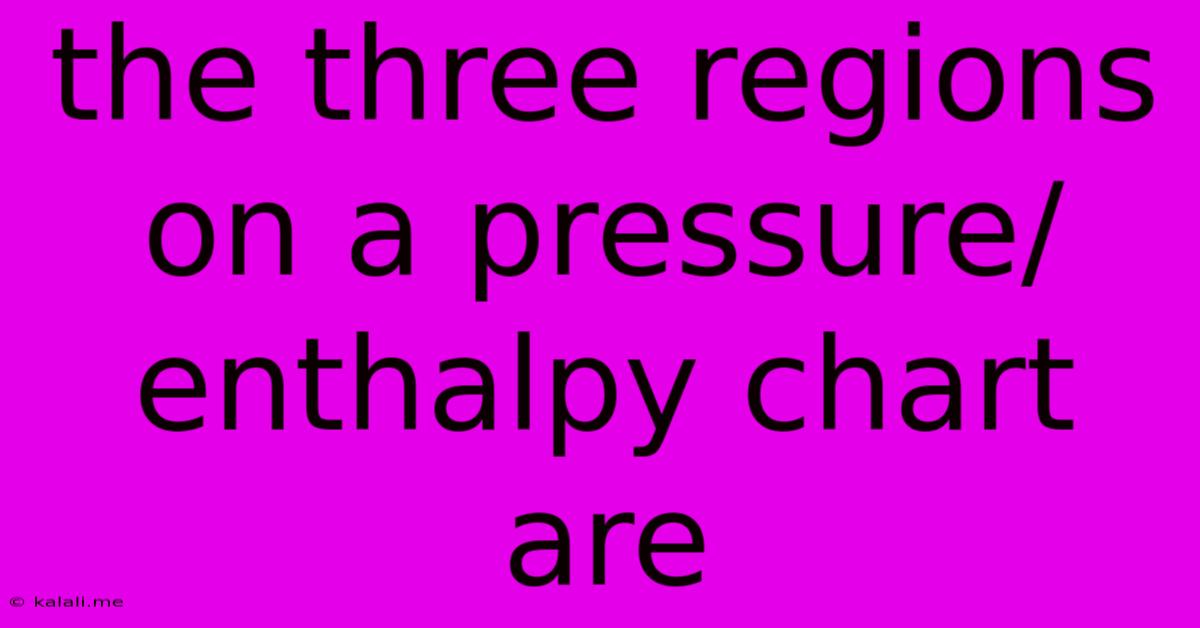The Three Regions On A Pressure/enthalpy Chart Are
Kalali
Jun 14, 2025 · 3 min read

Table of Contents
Understanding the Three Regions on a Pressure-Enthalpy (P-h) Chart
The pressure-enthalpy (P-h) chart, also known as a Mollier diagram, is a powerful tool used in thermodynamics, particularly in refrigeration and power cycles. It provides a visual representation of the thermodynamic properties of a substance, primarily pressure (P) and enthalpy (h), allowing for quick determination of state changes and calculations. This article will delve into the three distinct regions depicted on a typical P-h chart: compressed liquid region, saturated mixture region, and superheated vapor region. Understanding these regions is crucial for analyzing various thermodynamic processes.
The Compressed Liquid Region:
This region represents states where the substance exists as a liquid under pressure significantly higher than its saturation pressure at a given temperature. In this state, the liquid is considered "compressed" because it's subjected to pressure exceeding what's necessary to maintain its liquid phase. The enthalpy values in this region are relatively close to the saturated liquid enthalpy at the same temperature. This region is often depicted on the left-hand side of the P-h chart, below the saturated liquid line.
- Key Characteristics:
- High pressure
- Primarily liquid phase
- Enthalpy values slightly higher than saturated liquid enthalpy at the same temperature.
- Small changes in enthalpy with significant pressure changes.
- Often simplified in calculations by assuming properties are similar to those on the saturated liquid line.
The Saturated Mixture Region (Two-Phase Region):
This is the central region of the P-h chart, positioned between the saturated liquid line and the saturated vapor line. It represents a state where the substance exists as a mixture of liquid and vapor in equilibrium. The proportion of liquid to vapor is determined by the quality (x), which ranges from 0 (100% liquid) to 1 (100% vapor). The quality (x) is a crucial parameter within this region. Knowing the pressure and quality allows for the determination of specific enthalpy using the following equation: h = h<sub>f</sub> + x(h<sub>g</sub> - h<sub>f</sub>), where h<sub>f</sub> is the saturated liquid enthalpy and h<sub>g</sub> is the saturated vapor enthalpy.
- Key Characteristics:
- Coexistence of liquid and vapor phases
- Defined by quality (x), the mass fraction of vapor
- Constant pressure during phase change (isobaric process)
- Enthalpy varies linearly with quality
The Superheated Vapor Region:
Located to the right of the saturated vapor line, this region portrays states where the substance exists entirely as vapor, and the temperature is higher than its saturation temperature at the given pressure. The vapor in this region is called "superheated" because it's heated beyond its saturation point. The enthalpy values in this region are considerably higher than the saturated vapor enthalpy at the same pressure. This region is characterized by significant enthalpy changes with temperature and pressure variations.
- Key Characteristics:
- High temperature
- Entirely vapor phase
- Enthalpy significantly higher than saturated vapor enthalpy at the same pressure.
- Significant changes in enthalpy with changes in both temperature and pressure.
Conclusion:
Understanding these three distinct regions on a P-h chart – the compressed liquid, saturated mixture, and superheated vapor regions – is essential for accurately analyzing thermodynamic processes involving phase changes. This knowledge is particularly vital in engineering applications such as refrigeration, power generation, and air conditioning system design, providing engineers with a valuable tool for calculations and process optimization. By correctly identifying the state of a substance on the P-h chart, one can determine its properties and predict its behavior during thermodynamic processes.
Latest Posts
Latest Posts
-
Who Opened The First Psychology Laboratory
Jun 14, 2025
-
Difference Between Adipose And Areolar Tissue
Jun 14, 2025
-
Which Of The Following Are Components Of M1
Jun 14, 2025
-
Order Of The Distinguished Rule Of Izzuddin
Jun 14, 2025
-
When Water Freezes What Happens To Its Density
Jun 14, 2025
Related Post
Thank you for visiting our website which covers about The Three Regions On A Pressure/enthalpy Chart Are . We hope the information provided has been useful to you. Feel free to contact us if you have any questions or need further assistance. See you next time and don't miss to bookmark.